The content of the article
- 1 Why sterilize cans for preservation
- 2 Preparing cans before starting the process
- 3 Methods for sterilizing cans
- 4 Video: how to sterilize cans in the microwave
- 5 Video: how to sterilize cans in the oven
- 6 How to sterilize jars with blanks
- 7 Useful tips for disinfecting cans
- 8 Video: cleaning cans and lids before canning
- 9 Storage of sterilized containers
- 10 How to sterilize different types of caps
- 11 Frequently Asked Questions About Sterilization
- 12 Video: 5 Ways to Sterilize Jars
Summer is the time for fresh fruits and berries, healthy and rich in valuable substances of vegetables. It is during the summer period that people most of all try to acquire different fruits on the market or grow their own hands on a summer cottage. Summer residents grow such a crop not only in order to provide their diet with fruits from the personal garden, but also roll them in sufficient quantities to last until the new harvest season. The best option in this case is canning.
Surely, everyone in the preparation of blanks for the winter faced a problem associated with improper storage of cans. Often the marinade in the container becomes cloudy, mold occurs, in some cases the cans “explode” completely, spraying all the contents out. The reason for this is the various microorganisms that penetrated inside the harvesting jar and led to the development of the fermentation process. This occurs as a result of poor-quality dishwashing, improper heat treatment of vessels and the products themselves. As a result, the procurement, for the receipt of which a lot of money was spent and a lot of work was invested, has to be thrown out.
Why sterilize cans for preservation
The heat treatment of glass containers is carried out in order to destroy any bacteria and microbes that are on the surface of the dishes. If you ignore this stage of preparation of seals, you can allow the multiplication of microorganisms in a nutrient medium. A month after rolling up, the product will begin to ferment, and the lid will swell. It is already impossible to use such a product.
Is it obligatory to do this
It is very important to heat-treat the container and the product itself, since the reproduction of microbes can be dangerous to human health. If the rules for the production of winter blanks are not followed, you can get severe intoxication and get to the hospital.
Preparing cans before starting the process
No matter how strange it may sound, there is an opinion that containers that were previously used for such purposes are best suited for rolling products. This is due to physical science, in which there is the concept of "tempered glass." If new products are used, it is recommended to rinse them under running hot water both inside and outside before disinfection. This is necessary in order for the glass to get used to the effects of high temperatures.
As for the covers, it is best to use new ones every time. Although often spinning options are reused if they have not been spoiled after previous use. If such products have retained the smell of products for which they were previously used for clogging, you need to fill them with a special composition made from water and acetic acid or lemon juice for a while, and then rinse. When using metal covers with rubber bands, it is important to make sure that they all have a rubber part that is suitable for the parameters. If the cover has corrosion, do not use it, otherwise it will cause damage to the product itself during storage.
When using plastic caps, it is necessary to use a solution of soda, and then boiling water to clean them. Instead, they can also be soaked in water heated to 85 degrees for ten minutes.Refillable covers should have a holistic surface, without scratches and a damaged protective element. If previously dishes with such a lid were opened with a special opener, then often the side edges of such a part are crumpled in several places. They should not be used for blockage.
It is important to prepare pre-screwed covers for a single glass product. It is recommended to tightly screw each on a glass container. If it does not scroll, it can be sent for disinfection. You can even pour water into it, about a glass, twist it, and then turn it over.
The main condition in the process of preparing containers for conservation is cleanliness. Therefore, used dishes and lids for them should first be washed in a warm solution of water with soda. The sponge or cloth used to clean such containers must be clean. It is even advisable to purchase a new sponge, in the future it can be kept separately and used only for washing cans.
If for work it is necessary to wash heavily contaminated containers, it is recommended to fill them with hot water in advance and leave to soak.
So, first you need to carefully examine all the banks. They should not have cracks and chips. To do this, you need to run your fingers along the neck of the container. If even minor defects were found, it is better to postpone it, since it will not be useful for such purposes.
All dishes should be thoroughly washed with household chemicals or with a solution of baking soda. You can use a dishwasher. And again, the neck of the product will require special attention. Often on this part there are rust spots and other contaminants that must be washed.
If a special detergent was used when washing dishes, rinse it thoroughly under running water so that no chemical substance remains on the glass surface.
After disinfection, the dishes must be turned over and laid out on towels so that all the liquid is glass. Such rags should be clean and ironed on the front and back sides.
It is recommended to decontaminate containers not earlier than a couple of hours before the product is clogged. Up to this point, it is important not to touch the neck of the dishes, so as not to again bring microorganisms into it, from which they have so far tried to get rid of it.
Methods for sterilizing cans
There are many methods designed to handle warm utensils during canning. Conventionally, they are divided into two groups. The first group includes classical methods that were used by our grandmothers. The second group consists of modern methods. In this case, some simple methods can be used that can be easily applied at home.
In the microwave
Today there is still debate about the appropriateness of using a microwave. Some are of the opinion that such a technique can destroy the structure of a dish and thereby harm the human body. Others do not agree with this and continue to use such a device in their kitchen.
But now another area of application of the microwave is known. It can be used to disinfect cans, however this option is suitable when the jars are small in size. Indeed, in this technique only one three-liter jar can fit, and lying down.
So, the containers should first be washed with a soda mixture and pour a few centimeters of water into each of them. If the vessel is three liters, you will need to pour a glass of liquid. Next, immerse the cans in the microwave, leaving a little distance between them. After that, set the device power to 800 W and sterilize. For small jars up to 1 liter, three minutes will be enough, for three-liter jars - six.The main condition: you need to detect this time from the moment of boiling of the liquid in the container.
After this time, the dishes should be removed using dry gloves, pour the remaining liquid from it and put on a dry rag. It is important to immediately fill the container with blanks.
Note! Metal caps cannot be sterilized using this method.
Some housewives even use a microwave for heat treatment of cans filled with blanks, and then pour boiling marinade into them. It is possible to disinfect them in this way, but it is still not recommended.
Video: how to sterilize cans in the microwave
In a slow cooker or a double boiler
Today, almost every housewife can boast a slow cooker designed for the manufacture of various dishes. It can also be used for heat treatment of dishes.
To sterilize containers for canning with a slow cooker, you must start the process with washing dishes. This is the very first step, whatever method is used. Next, thoroughly clean the appliance bowl. Very often, it retains the odors of food cooked in it. It is advisable to eliminate them, otherwise the banks will absorb these odors during heat treatment. You should also clean the grill, which is an integral part of the technique. It is used for steaming food.
After that, three glasses of water must be poured into the capacity of the multicooker and a special grill should be fixed. Next, set the banks with the neck down. There is no point in closing the cover in this case. Then you need to click on the “Steam cooking” button, if there is no such mode, you can turn on the “Soup” function and after boiling the liquid transfer to “Braising”. From the moment of boiling, processing of 0.5-liter cans should take about ten minutes, for liter cans it will take five minutes more.
Place the processed containers with the neck down on a clean rag.
If there is a double boiler, it is also possible to process glass containers before preservation. It can also be used not only for its intended purpose. Everything is pretty simple. First, pour liquid into the water tank. Then place the dishes with the neck down and cover the double boiler. Further, the equipment should work for 15 minutes. After this time, you can get clean dishes. This method is one of the safest.
In the pan
A cauldron with boiling liquid in it is considered one of the classic options for thermal disinfection of glassware. To do this, it is recommended to use dishes with a large diameter in order to process as many containers as possible at a time. At the bottom of the dish should lay a fabric layer and pour cold water. The level should be such that the glass products are completely immersed in the liquid. Pre-washed containers must be laid up at the bottom of the container. You should not put them very close to each other, otherwise, after boiling, they will begin to burst. From the beginning of boiling, disinfection should continue for 10-15 minutes. After this period, you need to carefully get the cans one at a time, using special devices.
The same pan can be taken to disinfect the lids. Clean containers should be laid upside down on a clean towel, which is recommended to iron with iron on both sides before use.
For a couple
This version of the heat treatment of glass vessels before preservation is also known for a long time and does not require special devices. The only thing that is useful is a lattice with holes, on which glass containers are laid out. You can buy such a grill in a store or use a colander or sieve for this.
Pour water into the pan, filling two-thirds of the vessel, install the wire rack. Next, put the banks upside down on this grate.After boiling the liquid, disinfection lasts 10 minutes, if the container volume is two liters or less, it will take 15 minutes for a larger container. The readiness of the cans can be judged by the droplets of water that will drain along the inner wall. Sterilized jars should be placed with a throat down on a clean towel. After such sterilization, the dishes can be used for two days, but provided that they have not been touched or touched the neck.
Sterilization with boiling water
This option for disinfecting dishes is recommended to be used when only a few cans need to be processed. It is important in this case, thoroughly wash the dishes in solution with the addition of a special chemical agent or ordinary baking soda. Next, the container should be washed under the tap. Then it is necessary to place a large spoon in the vessel and pour the boiling water gently into it. In this case, the jar should be filled with boiling liquid about a quarter. It is necessary to pour slowly, in a thin stream, since glass does not tolerate sharp temperature jumps.
The used spoon should also be sterilized, for this it needs to be rinsed with boiling water before starting work.
You can apply another way - to put a knife blade under the can. In this case, the spoon no longer needs to be used. However, water must also be poured slowly, in a thin stream. For best results, it is advised to cover the dishes with a pre-processed lid and let it cool in this state for about ten minutes.
After this, it is required to process with hot water and the inside of the dishes. To do this, it is enough to chat the liquid inside the glass product and pour it, and turn the container upside down and put on a clean rag. It is necessary to wait for all the glass water inside and the container to dry.
The disadvantage of this processing option is that the glass container may burst if there is not enough experience and all the requirements are not met. This happens if you pour too much boiling water into the container at once. Glass does not have time to get used to the heat and bursts.
In the oven
Disinfecting glass dishes in the oven is convenient because more containers are placed in it, taking into account the volume of the dishes. A mandatory preliminary step is to thoroughly wash the cans using special substances. Place the cans and lids in the oven, which does not need to be preheated, with the mouth down. You can spread them upside down if there is liquid left in the jar after washing, but in this case, after heat treatment, non-hazardous, but not very aesthetic white traces will appear on the bottom of the container.
Lids can be laid out near cans. Now you need to set the "Convection" mode with blowing or double-sided heat at a temperature of 150 degrees. It takes about a third of an hour to disinfect 2-, 3-liter cans, it takes 15 minutes to process a liter capacity, but 10 is enough for smaller ones.
The jars should be removed using mittens, but it is important that they are dry, otherwise the container will burst. To clog hot products, cans can be filled immediately, while for cold ones, containers need to be slightly cooled.
As for the oven included in the gas stove set, the principle of operation is almost the same as with the electric one. Although there are still some differences.
As in the first embodiment, the container must be placed in a cold oven. Do not put the jars very tightly, as this will lead to the fact that they will begin to burst.
First, you need to preheat the oven very slightly, to 50 degrees, and after a few minutes, increase the figure to 180 degrees. Processing time is the same as with the electrical counterpart. After disinfection is complete, open the appliance door and wait for the dishes to cool slightly. It is important to use gloves so as not to burn yourself.
Video: how to sterilize cans in the oven
Over the kettle
This method was also used by our grandmothers.It is very simple and convenient. The disadvantage of this treatment is that the work is carried out very slowly, since in this case one can be disinfected. Nevertheless, the method is popular if applied, for example, in the country, when it is necessary to roll up only a few jars. Large containers should be sterilized for 15 minutes, and for a small container, 10 will be sufficient. In the case of small containers, you can use only the spout of the kettle. A large jar can be processed on the neck of the dish.
In the dishwasher
It is worth noting that such processing does not guarantee that all microbes will be destroyed, since most of these devices have a maximum heating temperature of up to 70 degrees. However, if you plan to roll up jam or jam, such heat treatment will be enough. Such a device is less commonly used for disinfecting cans, but is great for washing and drying cans that will be stored until next year.
The maximum temperature of such equipment is only 70 degrees, while when exposed to boiling water or steam - 100. But still the method works. Therefore, if the kitchen has such a modern helper as a dishwasher, you can use it to disinfect glassware. It is very easy to do. You just need to load clean glass containers into the machine, preferably upside down, and turn on the desired mode, in which the temperature will be above 60 degrees. Next, turn on the device, as usual. There is no need to use any detergents. After the cycle is completed, the cans should be removed and laid out on a clean towel in the same position.
In the air grill
Aerogrill is another modern technique that can also be used to destroy microorganisms hazardous to health in the manufacture of winter blanks. The principle of operation is not complicated. You must first put the grill in the aerogrill to the lowest position. Next, install banks in the device. There should be space between each product. After that, it is necessary to select a temperature of 160-180 degrees on the equipment. To process small dishes, the timer should be turned on for eight minutes; for large containers, sterilization should last a quarter of an hour.
Vinegar, alcohol and potassium permanganate treatment
Quite common is sterilization using vinegar. This method does not require special financial costs and is very easy. For work, you need a solution of acetic acid, the concentration of which is 70 percent. Such a composition will kill all pathogenic microbes. However, in order to get the result, it is important to adhere to a certain disinfection algorithm.
In order to sterilize cans at home in a short time, you must first fill the containers almost to the top with cold boiled water and add six tablespoons of 70-percent acetic acid. Next, the dishes must be closed with a plastic lid and shaken vigorously for about 30 seconds. After that, from one container, the solution can be poured into another and repeat the shaking procedure. Thus, you can prepare for use the required number of cans. Sterilized dishes must be left upside down to dry.
You can also pour in a clean container half a glass of ethyl alcohol with a concentration of 95 percent and close the lid. Then it is also required to vigorously shake the jar so that the liquid in it washed all the surface from the inside. Then pour the solution again into the next jar. Processed containers must be sealed tightly.
Potassium permanganate is also used to sterilize dishes. Use this method much less often, but still it exists. As usual, you must first thoroughly wash the jars.Next, dilute potassium permanganate in a warm or hot liquid. The resulting solution must be poured into a clean dish and shaken for several seconds so that all the walls of the container and its neck are treated with this mixture. After processing, drain the pink solution, and put the jar down with the neck so that excess liquid drains onto a clean towel. One portion of this composition is enough to disinfect several glass jars.
How to sterilize jars with blanks
Some prescription recipes indicate that sterilization of cans should be carried out along with the contents. Such processing is usually used in the preservation of vegetables, salads, mushrooms, etc. At the same time, pour water into the pan, taking into account the height of the cans. The fluid should reach the narrowing section of the containers.
Towel should be laid at the bottom of such a vessel and only then cans be placed. It is important to leave the distance between the containers. This is necessary so that the dishes do not break. Harvested jars must be covered with lids that are previously sterilized. When the water begins to boil, the three-liter jar should be decontaminated for half an hour, it takes 20 minutes to process two-liter containers, and smaller dishes can be exposed to high temperature for ten minutes. After that, you can carefully remove the cans and tighten the lids. Next, the finished workpiece should be turned upside down, covered with a blanket and left to cool.
Sterilization of cans with blanks is also carried out in the oven. This method is convenient in that you can process a lot of dishes at the same time, especially if the container is small. In this case, the container must be filled with food and slightly closed with a lid. It is important to remember that the temperature difference between the container and the workpiece itself should be minimal. That is, when rolling up a hot salad, it is recommended to hold the jar in hot water for some time. You can also fill the dishes with hot marinade gradually, in small parts.
The oven must be preheated initially to 50 degrees. Workpieces need to be immersed already in the heated equipment, and then increase the temperature to 150 degrees. Processing time is indicated above. When the time necessary for sterilization has passed, depending on the size of the cans, remove the blanks and tighten the lids tightly.
As you can see, there is a wide variety of can disinfection methods. Each hostess can use the most convenient way for her. You can even use several options. The main thing is that as a result, seaming will turn out that will delight your taste all winter until the new crop.
Useful tips for disinfecting cans
There are a number of principles that should be followed in such a procedure. When preserving, fruits and vegetables should be packed quite tightly in glass containers so that no air bubbles remain. To do this, press the workpiece with a spoon. If the bubbles still remain, it is important to release them using a knife or spoon, carefully releasing the tip along the edge of the container.
When pouring marinade, syrup and brine, it is necessary to pour in such a way that when the lid is applied, the liquid spills out and there is no air left in the container. It is oxygen that provides the reproduction of various microorganisms.
To prevent the jar from bursting when filling it with a hot billet, it is recommended to fill in the product a little, and pour the syrup in a thin stream. After filling the containers, they must be sent for heat treatment to the pan. Thirty seconds is enough for this.
The pan should be large and deep so that it can fit as many cans as possible. Containers with components should not be immersed in boiling liquid, but in hot, with a temperature of not more than 60 degrees. Cans should be covered with lids for the entire heat treatment period.
The bottom of sterilization dishes must be covered with a towel or gauze, which is folded in several layers. Such a fabric layer will protect the jar from touching the bottom of the cauldron, where the effect of fire is much higher. For such purposes, there are special lattices made of wood.
After immersing the billets in the pan, you need to add as much water as possible so that the liquid level reaches the can shoulders and a few centimeters remain to the neck. When it boils, you need to reduce the fire and adjust it so that the water does not boil and does not get inside the can.
The heat treatment time depends on many factors. In any case, you need to note the time from the moment the liquid boils. The duration of such a procedure depends on the acidity of the workpiece and the consistency of the final mass (the product is liquid or thick). So, the liquid mixture needs to be sterilized within 10-15 minutes, while disinfection of a thick product may take up to two hours.
If the workpiece contains acid in the form of essence or vinegar, then the sterilization time is reduced. If there is no acid in the product, the boiling period increases. Each individual product has its own processing time, as a rule, this is indicated in each recipe.
In addition, the heat treatment time depends on the volume of the tank. Therefore, the larger the container, the longer it takes to process. In recipes, this is usually not indicated.
You need to get the cans very carefully. It is important to ensure that the cover does not open. If this happens, add a little more marinade or syrup to fill the jar to the top and repeat the sterilization procedure. But the processing time in this case can be reduced.
After rolling up, the container should be installed upside down on a towel so that it does not come into contact with other dishes. Sometimes it is necessary to cover the workpieces with something warm in order to prolong the effect of heat. In some cases, on the contrary, it is important to cool the canned product in a short time. This is usually also indicated in the recipe.
Video: cleaning cans and lids before canning
Storage of sterilized containers
There are many ways that help to destroy various pathogens and bacteria. So, you can sanitize cans for preservation in boiling water, in the microwave, in the oven, etc. But as it cools down, the sterility of the processed dishes decreases. You can store disinfected containers for 1-2 hours. In general, it is recommended to sterilize dishes immediately before filling them with the finished product.
How to sterilize different types of caps
Another important point when preserving blanks for the winter is the sterilization of covers. Without such treatment, microbes will develop in the bank. It is important to follow basic recommendations and instructions. The inner surface of such products must be intact, without any mechanical damage. In half of the cases, it is damage to the covers that leads to spoilage of rolled-up products. Tin covers screwed into the machine should only be used once. If the can was opened with an opener or knife, it loses its original form. This cover should not be used, because its tightness is already broken.
The temperature at which sterilization should be carried out is 100 degrees, and for gum this indicator decreases to 75.
Often, housewives thoroughly disinfect the containers, and only cover the lid with boiling water. This is not recommended, as this may cause the workpiece to deteriorate. First, such parts must be washed, and then subjected to heat treatment. Microwave lids cannot be sterilized.
It is enough to boil metal products for five minutes or immerse them together with banks in a double boiler.An oven for such purposes is also not recommended, since the rubber layer can melt.
The capron cap should be placed in a small bowl and filled with boiling water. They can be removed only after the water has cooled to such a temperature that you can hold your hands in it.
Lids made of glass must be sterilized simultaneously with the container. The rubber gasket must boil separately.
Frequently Asked Questions About Sterilization
The basic rules and features of the heat treatment of glassware are described above. If you follow the entire sequence of the process, you can ensure reliable and long-term storage of workpieces. Nevertheless, there are a number of issues that arise when sterilizing dishes.
How many minutes to sterilize
Sterilization time depends on the processing method and the volume of cans used. So, if the disinfection is carried out by steam, a small container can be sterilized for ten minutes, liter cans - a quarter of an hour, two-liter dishes - about a third of an hour. If we are talking about a three-liter can, the heat treatment should last half an hour.
In a microwave oven, dishes should be sterilized five minutes after the boil begins.
To disinfect in the oven, the cans are immersed for the same number of minutes as when exposed to steam.
At what temperature can the jars be sterilized
The temperature of processing containers before canning varies depending on the selected method of heat exposure. If water is used to prepare cans, then sterilization begins during the boiling of the liquid, therefore, the temperature of the water reaches 100 degrees.
In the case of sterilization in a microwave oven, the power of the equipment should be up to 800 watts. The temperature in the oven should be up to 150 degrees.
Why cans burst during sterilization
Often during the preparation of products for the winter, you may encounter the fact that the jar bursts or cracks appear on it, which makes it impossible to further use it in the kitchen. Glass is a brittle material, so dishes from it can easily crack from a weak impact, as well as from jumps in temperature indicators. If the cans are washed and rinsed in cold water, they burst when exposed to boiling water. The glass container explodes even after removing it from the hot appliances in a cool kitchen.
Although there is another explanation for the fact that the banks burst. It turns out that the whole point is that glass is a liquid with a high viscosity. When heating or cooling, expansion can occur at the so-called wrong point of internal stress. To prevent this, when pouring boiling water into a chilled container, you must use a spoon or lay out the cans on a metal wire rack.
Video: 5 Ways to Sterilize Jars

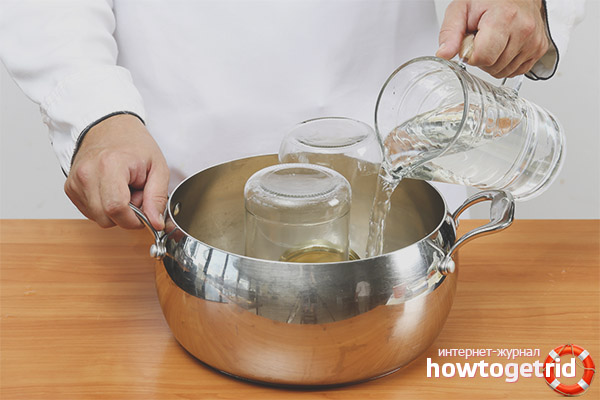
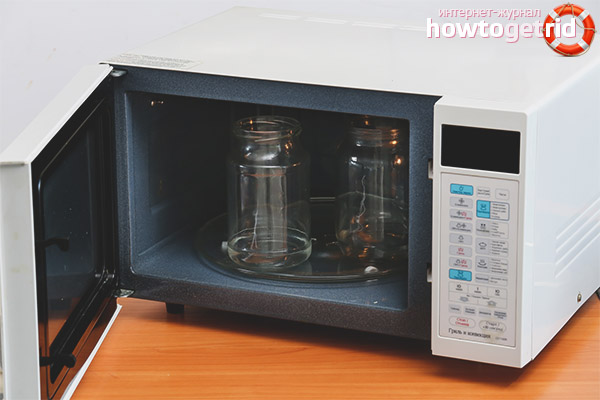
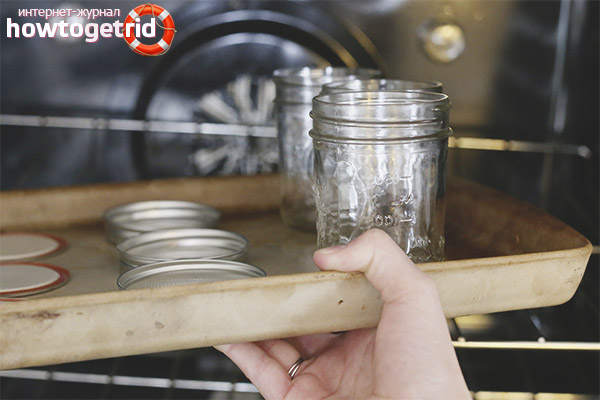
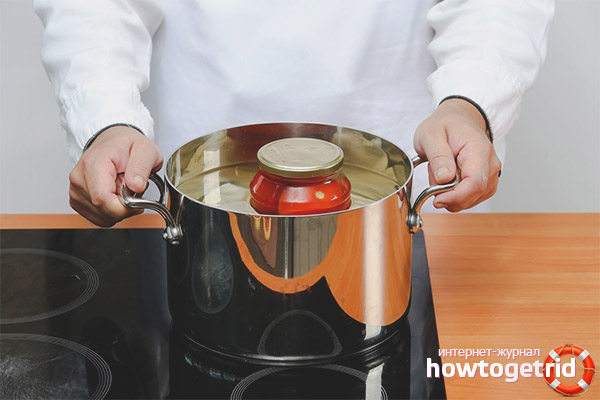
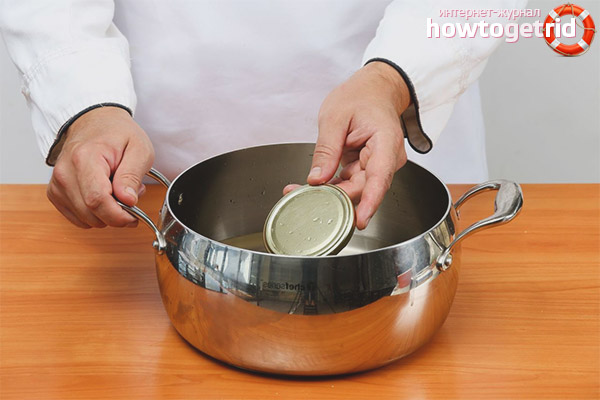








Submit